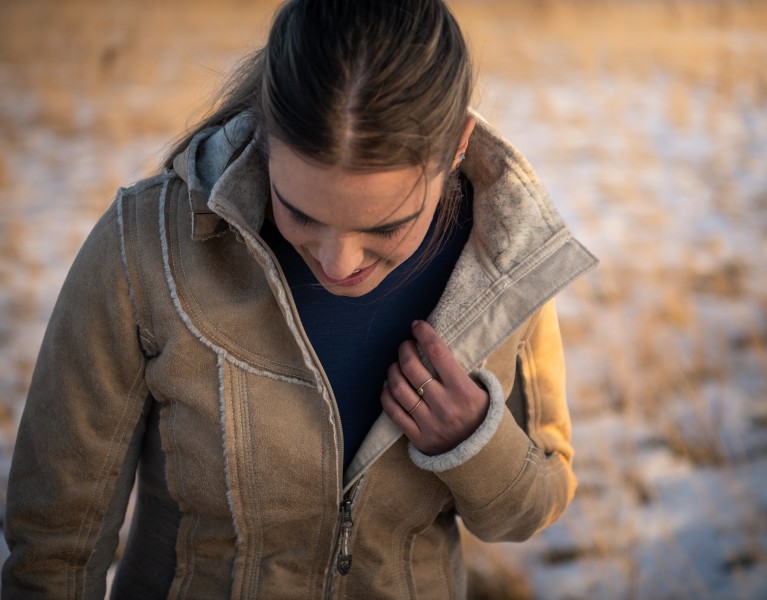
What Is A Sherpa Jacket? A Quick Introduction
Table of Contents [Show]
To wrangle with the elements is what it means to be human. The weather creates obstacles for us by introducing cold, wet, dry, hot, and humid temperatures. One of the more difficult temperatures to deal with is the cold. Let’s face it, nobody likes being cold, so the obvious solution is to cover our bodies with warm, cozy clothing.
In years past, humans used leather, wool, and fur to stay warm through the harsh winters. Now, in the 21st century, we have the technology to create such warmth through alternative or faux materials. Sherpa is one of these materials, and a sherpa jacket is an ideal item to withstand the cold.
Read on to discover what makes a sherpa jacket the warm, cozy, and stylish must-have for your winter wardrobe.
What is a Sherpa Jacket?
Sherpa, also known as faux shearling, is a type of fabric made from a variety of materials such as polyester, cotton, or acrylic. Real shearling is sheepskin that has been tanned and dressed with the wool still intact. The term comes from the Sherpa people of Nepal who traditionally use shearling to make their cold-weather clothing.
Sherpa material, which is designed to mimic the look and feel of shearling, is an ethical alternative to the real thing. Just like real shearling, the fabric has two sides - an inner lining with a soft, bumpy texture, and a smooth outer shell. They combine to make warm, durable fabric for jackets.
A sherpa jacket is designed with warm and cozy faux sheep’s wool on the inside, creating the ideal insulation for cold weather. The shell of the jacket displays a soft suede- or leather-like feel while also looking incredibly stylish. There are also sherpa denim jackets, sherpa corduroy jackets, and sherpa trucker jackets, but they are best known to have a faux leather exterior. Though sherpa jackets are incredibly similar to fleece, there are some noteworthy differences.
Sherpa vs. Fleece
Sherpa is actually part of the fleece family. Sherpa fleece, however, has its own unique qualities that make it stand out from other types of fleece.
- Used mainly as a lining inside other fabrics such as faux leather, corduroy or denim, it's one of the warmest fleece options you can buy.
- Sherpa is incredibly soft, fluffy, and textured to resemble fleece from real sheep. It's usually softer than other fleece materials.
- Sherpa fleece is not as bulky as other fleece, making it the perfect cozy coat lining.
- It's bonded to an outer shell to create a durable, windproof jacket. Other types of fleece don’t insulate as well against the cold.

Are Sherpa Jackets Warm?
One of the best-known characteristics of sherpa is its ability to retain warmth and preserve heat. Its two-sided fabric, smooth outer shell, and fluffy lining create strong insulation and offer excellent protection from the wind and frigid temperatures.
For this reason, sherpa jackets are perfect to wear hiking. Not only are they great at retaining warmth, but the faux-shearling lining also wicks away moisture. That means you'll be warm and dry even on the toughest cold-weather hikes. Another bonus, even though sherpa fleece is thick and fluffy, it's actually lightweight and won’t feel bulky as you hike.
Featuring superior comfort and warmth, the KÜHL Dani Sherpa™ series offers lightweight yet durable construction. The ÄLT LEATHER micro suede outer shell is bonded to premium Italian shearling fleece for a luxurious feel and unmatched comfort even in the coldest temperatures.
How Do You Maintain a Sherpa Jacket?
Maintaining your sherpa jacket is quite simple as long as you follow some important steps that will allow for a long-lasting, durable jacket. First and foremost, you should always follow the care instructions that are attached to your outerwear.
Here are some guidelines for washing and drying your sherpa jacket:
How to Wash a Sherpa Jacket
Check the tag first for specific washing instructions. Depending on the fabric, style, and manufacturer, there may be special instructions. You can typically wash a sherpa jacket with a machine or by hand.
When washing by machine
- Turn the jacket inside out to stop from piling.
- Use about 1 tablespoon of mild, liquid detergent. Do not use detergents that are powdered or contain bleach, as this can ruin the outer shell and the softness of the sherpa.
- Set the machine to delicate mode with cold water only. Warm to hot water can damage the material.
- Wash jacket by itself for best results.
- Do not add any fabric softener.
When washing by hand
- Use cold water and a few drops of mild liquid detergent in a large sink or tub.
- When finished, rinse with cold water until no suds remain.
- Do not wring the jacket. It’s best to shake the jacket to get rid of excess water.
How to Dry a Sherpa Jacket
The best possible way to dry a sherpa jacket is by hang-drying or laying flat to dry. It is not recommended to place your sherpa jacket in a dryer. If it’s warm enough, hang the wet jacket outside on a clothesline or simply place it on a hanger or lay on a flat surface, reshaping if necessary.
Drying can take up to 24-hours, so to speed up the process wipe down the jacket with a soft, absorbent, microfiber cloth. While the jacket is still wet, however, you should re-fluff your sherpa fleece for optimal performance and care.

How to Maintain Sherpa Fleece
When your sherpa jacket comes out of the washer, there are a few important things you can do to ensure that your fleece maintains its soft, fluffy texture. You may also need to restore matted fleece to its original texture, as well.
When fleece fibers are damp, they are more elastic and pliant, so while still wet:
- Fluff sherpa fleece all over with your fingers.
- Use a bristle brush and gently comb it out in all directions.
- Concentrate on more matted areas by pushing down with a brush and drawing fibers out, gently shaking brush side to side to loosen larger clumps.
How to Maintain Faux Leather
If your sherpa jacket has a faux leather or suede outer shell, you can easily take care of the stains without having to throw it in the washer.
Blot the stain with a soft cloth to remove any excess liquid. Then soak the stain with mild soap for up to 10 minutes. Next, gently scrub the area in a circular motion with a toothbrush or soft sponge. Rinse with cool water and hang outside to dry.
Never rub the stain with a cloth as this will cause it to set deeper into the fabric. For more stubborn stains use an equal mix of white vinegar and water with baking soda instead of mild soap.
How Do You Wear a Sherpa Jacket?
Sherpa outerwear is a high-performing blend of form, function, and style. Wonderfully warm, durable, and great for anyone looking for stylish yet functional clothing, you can choose between a jacket, a trench, or a vest. They are lightweight, delightfully soft, and easy to maintain, which makes them perfect for everyday adventuring in the coldest of temperatures.
- The KÜHL Dani Sherpa™ Jacket is the ideal balance of style and warmth. It's a great option for any outdoor activity in the fall and winter, as well as for everyday wear. Winter warriors especially love this jacket because it not only keeps them warm and comfortable but also looking effortlessly cool.
- Constructed to be lightweight and durable, KÜHL's Dani Sherpa™ Vest is perfect for chilly early morning hikes, especially when layered with a cozy sweater or comfy long sleeve shirt. Its wool-blend fleece side panels reduce bulk and add extra stretch. The extended fleece collar and zippered pockets add warmth and dimension to this vest.
- The KÜHL Dani Sherpa™ Trench delivers on both form and function. This longer, vintage-style jacket looks classy with luxurious details like high-gauge stitching and ÄLT LEATHER SHEARLING™ fleece. It features a removable hood and belt detail for a more feminine fit.
Rugged, fleece-lined, and insulated, the best sherpa jackets are built for premium winter performance. They're also a more animal-friendly and less expensive alternative to real shearling jackets. For the best combination of classic style, quality performance, and pure comfort, choose one of the KÜHL sherpa jackets and venture out into the outdoors!
Also, check out how to Care For Your Down Feather Jacket.


